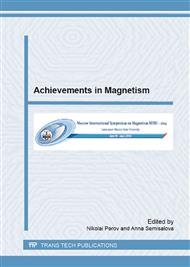p.690
p.694
p.699
p.705
p.709
p.713
p.717
p.725
p.729
Structural and Magnetic Properties of Annealed Vapor Deposited CoxCr1-x Thin Films
Abstract:
Abstract. We prepared, under vacuum and onto monocrystalline silicone and glass substrates, series of CoxCr1-x thin films, with x ranging from 0.80 to 0.88. The structural and magnetic properties of the as deposited films have been performed using Rutherford backscattering spectrometry (R.B.S.), X-ray diffraction (X.R.D.), Alternating Gradient Field Magnetometer (A.G.F.M.), and Brillouin Light Spectrometry (B.L.S.) techniques. Once the films being annealed under vacuum, for 1 h at 700°C, in a pre-heated furnace, their structural and magnetic properties have been performed, by these tools, as well. Significant results have been found. The as deposited films present only an HCP structure and show a preferred orientation. The annealed films present both HCP and FCC structures. The annealed films possess cell parameters greater than the bulk ones which infer that they are under a tensile stress. The cell parameters of the as deposited films are lower than the bulk ones which infer that they are under a compressive stress. Up to the annealing temperature the films are still ferromagnetic and some decrease of the magnetic moment is noticed. In addition, coercivity and squareness have been strongly improved in the annealed films comparatively to the as deposited films. Moreover, the stiffness constant, computed using Brillouin light scattering measurements and after adjustment of theoretical and experimental results, is found to be far lesser than pure Co one. These results and others will be presented and discussed.
Info:
Periodical:
Pages:
709-712
Citation:
Online since:
July 2015
Authors:
Price:
Сopyright:
© 2015 Trans Tech Publications Ltd. All Rights Reserved
Share:
Citation:


